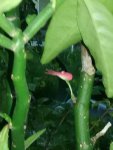Excellent! Identifying plants is hard for me and I amglad to get close to a bullseye! I read the wiki when I was looking and found these interesting points also:
ToxicityEdit
The roots, stems, and leaves of the plant are known to be toxic.
[4][18] These parts of the plant contain
euphorbol (a complex
terpene) and other
diterpene esters.
[4][18] These are also known
carcinogens.
[4][18] The plant's leaves and stems also contain
beta-sitosterol,
cycloartenone,
octacosanol, and
oxime, all of which have known medicinal as well as toxic properties.
[20]
Even minor amounts (a few drops) of the juice of the
Euphorbia tithymaloides root can irritate mucosal membranes.
[18] When ingested, the irritation of the mucosal membranes of the stomach and intestines will cause nausea and vomiting.
[4][18] Topical application causes skin irritation,
inflammation, and even blisters.
[4][18] If introduced topically to the eye, severe pain,
keratoconjunctivitis, and reduced visual actuity occur.
[4][18] Ingesting even a few seeds can cause violent and persistent vomiting and extreme
diarrhea.
[18]
If latex or root juice gets on the skin, the victim should immediately wash with soap and warm water.
[18] If
latex or juice gets in the eye, continuous rinsing with fresh water should be the first course of action.
[18] Topical steroids are indicated for skin or eye contact.
[18]Intravenous fluids are often administered to counteract the fluid loss due to vomiting and diarrhea.
[18]
Medicinal usageEdit
The root is known to be a powerful
emetic.
[2][18] A
proteolytic enzyme known as
pedilanthain can be extracted from the plant's latex, and has been shown in experiments to be effective against intestinal worms and to reduce inflammation when ingested.
[18][20] In 1995, a
galactose-specific
lectin was purified from the plant's latex, and indications are that it might be useful in combatting
diabetes mellitus.
[21]
In
folk medicine, tea has been brewed from the leaves which has been used to treat
asthma, persistent coughing,
laryngitis,
mouth ulcers, and
venereal disease.
[18] Tea brewed from the root has been used as an
abortifacient.
[18] The latex has been used topically to treat
calluses, ear ache, insect stings,
ringworm,
skin cancer, toothache,
umbilical hernias, and
warts.
[18] None of these uses has been scientifically verified as effective.
[18] In the
West Indies, a few drops of the latex is added to milk and used as an emetic.
[4]



